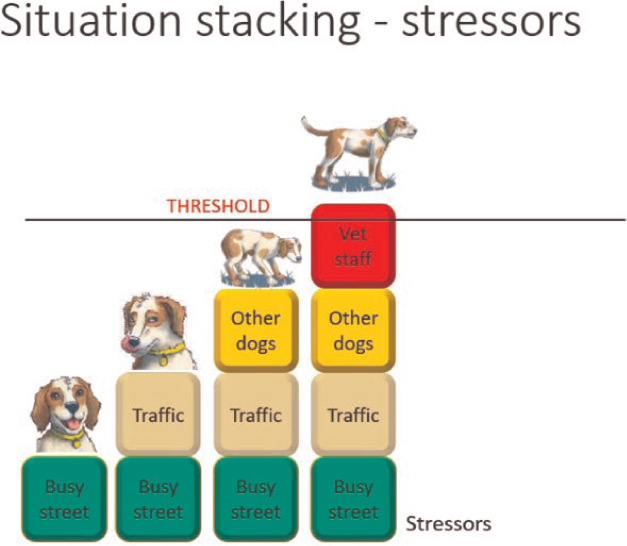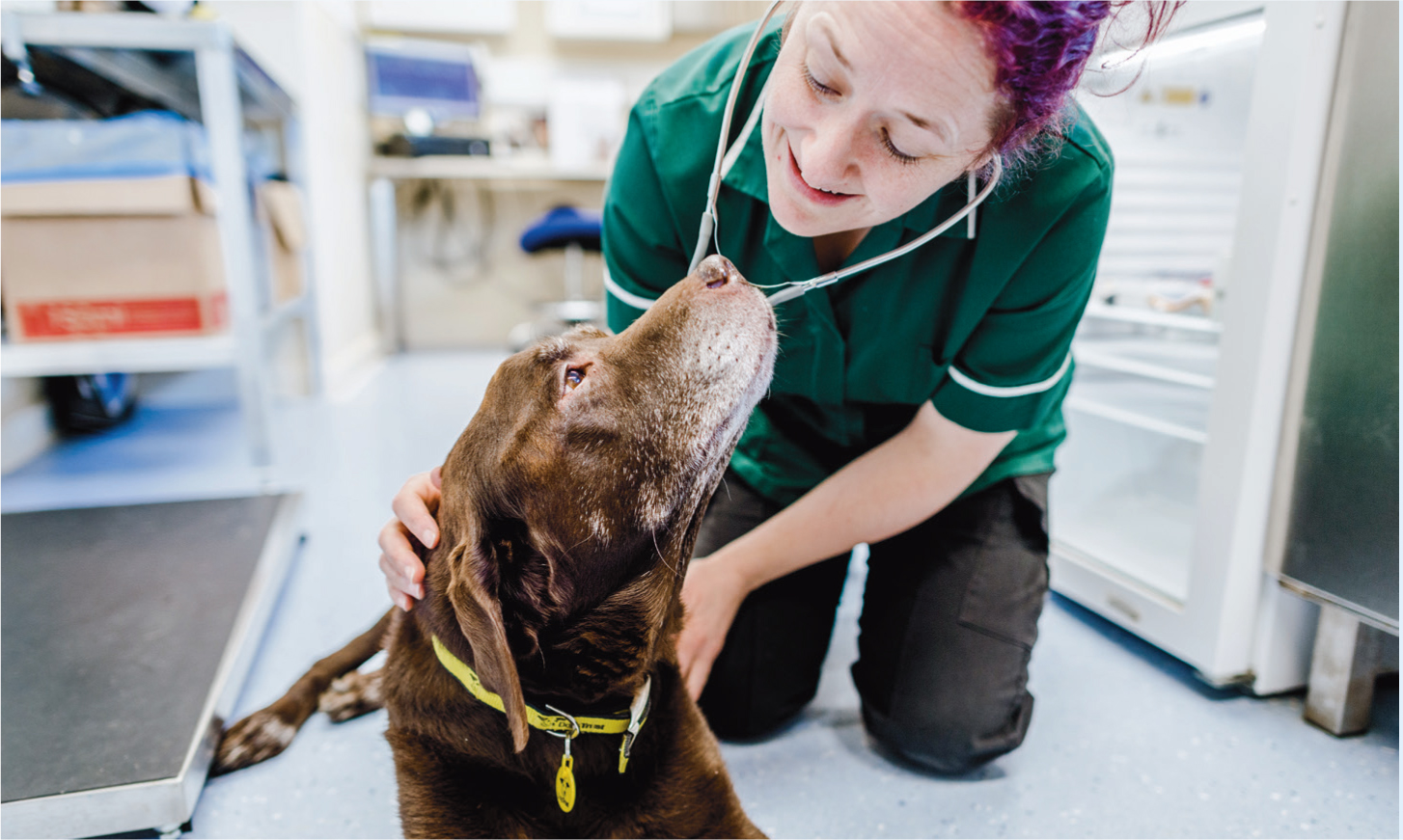The dog friendly clinic scheme is an exciting collaborative initiative between Dogs Trust, the UK's largest canine welfare charity, and the British Veterinary Behaviour Association (BVBA). The aim of the scheme is to make the provision of veterinary care as comfortable as it can be for all involved.
To support this aim and help clinics throughout the nation, the membership scheme has freely available web-based modules for veterinary professionals to explore (www.dogfriendlyclinic.org.uk), which provide insight into the importance of adopting behavioural principles within the clinic alongside supporting potential members with their dog friendly clinic application.
Veterinary professionals can join the scheme either as an individual or as a clinic team by completing a role specific application form. Upon meeting the criteria set out by Dogs Trust and the BVBA, applicants are invited to join the scheme and pay an annual membership fee. Membership benefits, such as behaviourally focussed CPD supports veterinary professionals in furthering their knowledge of canine behaviour while their dog friendly clinic certificates and badge(s) publicise that they are part of our behaviourally centred community.
The scheme launched last year and has already received positive feedback from its members: ‘Having the dog-friendly title helps us support our patients and clients even further, while developing as a practice.’ Domante Semetaite, lead nurse.
‘By becoming a member of the dog friendly clinic scheme, I now have access to lots of useful and interesting CPD as well as gaining skills to provide behavioural support to dogs, offering them a much more positive association with the veterinary environment and ultimately, we can make the vet clinic a much more positive and welcoming environment for our dogs even with small adjustments. The scheme also provides lots of information on how to direct dog guardians to accredited dog trainers and behaviourists, enabling them to access support and hopefully lessen the chance of relinquishment for behavioural reasons.’ Gemma Marke, veterinary nurse assistant.
Journey through the dog friendly clinic
There are four key touch points that veterinary teams have with owners and/or their dog during the veterinary clinic journey – pre-appointment, reception and waiting area, consultation, hospitalisation. Within each of these areas the dog friendly clinic scheme advocates that there are many small changes that can be made to improve in-clinic welfare.
Each veterinary clinic is unique and current dog friendly clinic members have had to consider each of these touch points and implement new protocols, behaviours and strategies, or adapted their clinic layout, striving to make a positive difference for their patients and owners.
Key considerations
Pre-appointment advice
Dog friendly clinics communicate with the owner before the visit, highlighting the importance of bringing items such as their dog's own cosy blanket and toys/treats to help make their dog feel relaxed during their visit.
Through the learning modules, clinic staff feel confident in explaining how the journey to the clinic can impact on their dog's emotional experience during the veterinary visit. They are able to highlight the benefits of a calm journey to reduce situation stacking (Figure 1).

Additionally, owners are encouraged to read the dog friendly clinic ‘Vet Visit’ resources to further explore strategies to facilitate a positive veterinary visit (https://www.dogstrust.org.uk/dog-advice/health-wellbeing/vet-visit). Practical suggestions for the visit, based on discussions with the owner and/or any behavioural history in the clinical notes are explored, such as whether the dog would prefer to wait in the car when they arrive.
Access to additional behavioural support prior to the appointment, such as muzzle training appointments and socialisation and habituation appointments and events are offered if appropriate.
The reception and waiting area
Dog friendly clinic waiting areas will have been adapted to reduce both inter- and intra-species interaction.
Some clinics already have separate dog, cat and exotic pets waiting areas, others have adapted their current wating area, for example, by repositioning chairs so that they are back-to-back and not immediately adjacent. This small change increases the space between patients and helps to reduce dogs having direct eye contact with one another.
Dog friendly clinic receptionists are pivotal in maintaining the relaxed and comfortable environment within the waiting room. They are empowered with a knowledge of canine body language and understand how they would confidently ask an owner to create more distance between their dog and another animal or person if they feel this is helpful or necessary.
Receptionists also understand the benefits of providing a variety of treats (unless contraindicated) for owners to use to reinforce desired behaviours, such as their dog sitting, laying down or settling on their blanket.
Consultation room
Dog friendly clinic veterinary nurses and veterinary surgeons have considered how best to positively introduce themselves and the consultation room. They let the dog sniff and explore the room while they take the clinical history from the owner.
They are also providing treats (if appropriate) for the dog, for example, scattering treats on the floor or using a lick mat, to provide a positive association with both them and the room.
If a clinical examination is performed (Figure 2), it is underpinned with behavioural considerations, using low stress handling techniques, for example approaching from the side, avoiding eye contact, and responding to and respecting how the patient is feeling during this examination.

Dog friendly clinic members understand the importance of writing any behavioural considerations in the clinical notes to aid future veterinary visits and to ensure the best possible lifelong clinic journey for their patient.
Hospitalisation
Dog friendly clinic members implement strategies to optimise positive emotions within the ward for their patients.
Kennels of various sizes are selected to suit different breeds and medical needs; bedding is comfortable and deep enough so that all body parts are protected and visual screening methods (such as a towel across half of the kennel front to provide a choice to hide if desired) are used if patients can see each other.
Personalised hospital plans are used to ensure all dog's individual preferences and needs are met. Current medication, diet, exercise requirements, behavioural concerns, grooming preferences and toileting habits are all recorded. Kennel enrichment such as interactive feeding toys and tactile stimulation like stroking or massage are considered, to ensure each dog has the best experience they can during hospitalisation.
Dog friendly clinic members discharge their patients, confident that they have provided the best emotional experience possible for the dog in their care.
The dog friendly clinic journey continues for all its members, with two new pieces of behaviourally focussed CPD provided every month.
Recent CPD topics that have been explored include:
- The ABCs of canine behaviour
- Canine body language
- The link between pain and behaviour
- Emotions behind behaviour
- Abnormal repetitive behaviours in dogs
- Behaviour medications
- First Aid for behaviour
- Canine hospice care.
Veterinary professionals interested in learning more about the dog friendly clinic scheme and to start their journey can visit www.dogfriendlyclinic.org.uk


